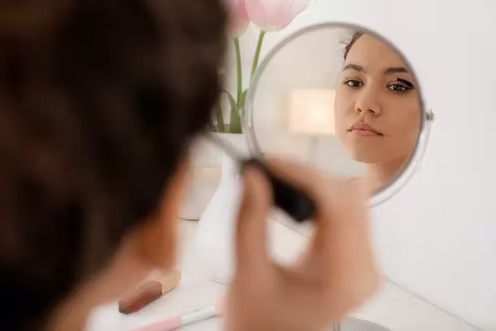Social media has long been a place for makeup enthusiasts and beauty gurus to discuss trends, but that’s not why TikTok users are currently talking about mascara. Young people are using “mascara” as a code word for talking about sex, relationships and assault.
Posts tagged with #mascaratrend generally feature young women using the term “mascara” and associated metaphors to refer to romantic or sexual partners. For example:
I found the best mascara ever but it changed and made my lashes completely fall apart and now I don’t know if I’ll ever trust any other mascara.
Some posts make more direct references to sex, using “(mascara) wand” as a code word for penis:
I love mascara but anything involving the wand terrifies me.
At the time of writing, the hashtag #mascaratrend has generated more than 122.7 million views on TikTok and a wave of social commentary. In part, it is a response to TikTok’s moderation policies – users have criticised its strict moderation of content about sex. Talking about “mascara” allows them to side-step moderation. In this way, the trend reflects longer histories of sex codes designed to get around censors.
Media standards have often constrained how explicitly sex can be discussed and presented in public. Under Hollywood’s “Hays Code”, films produced between 1930 and 1967 could not show “excessive and lustful kissing, lustful embraces, [and] suggestive postures and gestures”.
Instead, filmmakers used visual cues and metaphors to reference sexual activity. Famous examples include a crashing wave in From Here To Eternity, and a lighthouse in Casablanca plus lots of post-coital cigarettes.
More recently, contestants on reality romance show Love Island have used a colourful set of codes to describe the extent of their sexual activity.
Sex codes throughout history
These codes are doing more than simply avoiding censors. Put in historical perspective, the mascara trend is the latest in a long line of secretive ways young people have found to talk about sex.
The language – whether technical or sentimental – that adults use to discuss sex often doesn’t fit the conversations young people want to have. For example, they may not have words to describe acts such mutual masturbation – so code has been their only language for discussing their experiences.
In postwar Britain, young people ranked sexual activities and referred to these by numbers. This is similar to the American “base” system of sex activity, in which “first base” referred to kissing with tongues, building up to “fourth base/home run” which described penetrative sex.
Mainstream language is especially limited when it comes to talking about women’s bodies and female sexual experience. While young people today are more likely to know the anatomical terms for their genitalia than their predecessors, the language of vulvas, vaginas and penetrative sex can feel awkward and out of place in teenagers’ interactions with one another.
While codes enable young people to make reference to these body parts, it is possible that reliance on euphemisms exacerbates the taboo.

Coded language helps young people distinguish their sexual culture from other generations’. NDAB Creativity/Shutterstock
This question of whether codes are helpful or harmful has also been raised in relation to discussions of sexual assault. The mascara trend has prompted many young people to share stories of sexual assault.
For many survivors, it appears that being able to speak in code enables them to disclose experiences that they wouldn’t otherwise.
But this dynamic is complicated. Some sexual trauma professionals have celebrated this trend for how it has encouraged some people to seek support in the wake of assault.
But others have raised concerns that the “banter” aspect of the trend, the vagueness of the code, and the disembodied way in which it presents sexual activity and assault trivialises the issue.
Getting the joke
Codes are, by their nature, exclusionary to those who aren’t in on the joke. This can lead to confusion and negativity, especially on social media. Actress Julia Fox became an example of this when she had to apologise for leaving an insensitive comment on a “mascara” video about sexual assault.
But codes’ ability to separate those “in the know” from those who aren’t is crucial to how they function. Particularly for young people, codes allow them to distinguish their sexual cultures from those of adults and authorities.
In recent years, the use of terms such as “v-card” to refer to virginity and initial systems (such as “p in v” to refer to penis in vagina sex) are one example. The initial system reflects a more diverse sexual culture, and can be used to talk about LGBTQ+ sexual activity in a more inclusive way.
At a time when discussions about sexual culture are fraught, the mascara trend has also allowed young people to make sex funny. While the trend has a serious side, many of the posts are tongue-in-cheek. There is kudos to be gained by finding ways to play with the code, for example by extending the “makeup as sex” metaphor.
In addition to side-stepping censors and talking about aspects of sex that are otherwise hidden, codes like the mascara trend give young people new ways of talking about and imagining sex. It allows them to define sex and sexuality in their own terms.



 Trump Faces Mixed Reception at Kennedy Center Amid Conservative Overhaul
Trump Faces Mixed Reception at Kennedy Center Amid Conservative Overhaul  Disney Investors Demand Records Over Jimmy Kimmel Suspension Controversy
Disney Investors Demand Records Over Jimmy Kimmel Suspension Controversy  How Marvel’s Fantastic Four discovered the human in the superhuman
How Marvel’s Fantastic Four discovered the human in the superhuman  George Clooney Criticizes Trump’s Tariff Threat, Calls for Film Tax Incentives
George Clooney Criticizes Trump’s Tariff Threat, Calls for Film Tax Incentives  Paramount’s $108.4B Hostile Bid for Warner Bros Discovery Signals Major Shift in Hollywood
Paramount’s $108.4B Hostile Bid for Warner Bros Discovery Signals Major Shift in Hollywood  Disney’s ABC Pulls Jimmy Kimmel Live! After Controversial Remarks on Charlie Kirk Killing
Disney’s ABC Pulls Jimmy Kimmel Live! After Controversial Remarks on Charlie Kirk Killing  Trump Signals He May Influence Netflix–Warner Bros Merger Decision
Trump Signals He May Influence Netflix–Warner Bros Merger Decision  Trump to Pardon Reality Stars Todd and Julie Chrisley After Tax Fraud Conviction
Trump to Pardon Reality Stars Todd and Julie Chrisley After Tax Fraud Conviction  Google and NBCUniversal Strike Multi-Year Deal to Keep NBC Shows on YouTube TV
Google and NBCUniversal Strike Multi-Year Deal to Keep NBC Shows on YouTube TV  The Mona Lisa is a vampire
The Mona Lisa is a vampire  Netflix Shuts Down Boss Fight Entertainment, Developer of “Squid Game: Unleashed” Amid Gaming Strategy Shift
Netflix Shuts Down Boss Fight Entertainment, Developer of “Squid Game: Unleashed” Amid Gaming Strategy Shift  6 simple questions to tell if a ‘finfluencer’ is more flash than cash
6 simple questions to tell if a ‘finfluencer’ is more flash than cash  Mexico Probes Miss Universe President Raul Rocha Over Alleged Criminal Links
Mexico Probes Miss Universe President Raul Rocha Over Alleged Criminal Links 





























